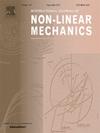复合推进剂粘弹性力学行为的拉压不对称性及微-介尺度耦合机理
IF 3.2
3区 工程技术
Q2 MECHANICS
International Journal of Non-Linear Mechanics
Pub Date : 2025-09-30
DOI:10.1016/j.ijnonlinmec.2025.105271
引用次数: 0
摘要
固体推进剂是颗粒填充的高分子材料,具有非线性粘弹性特性。本研究对固体推进剂进行了粘弹性压缩试验。压缩标称应力-应变曲线呈J型。松弛时间和粘性应力随变形的增大而增大。分析了粘弹性中的拉压不对称性。与拉伸相比,压缩产生更大的应力,更长的松弛时间和更大的粘性部分。通过自由体积理论和中尺度模拟分析了非线性松弛和拉压不对称的机理。在微观尺度上,有限的自由体积阻碍了大变形下分子网络和链段的重排。压缩下的自由体积越小,螺旋链段越多,应力越大,松弛时间越长。在细观尺度上,拉伸和压缩作用下的界面剥离和损伤演化模式不同。界面和颗粒之间的强度差异导致了不同的拉伸和压缩模量。微观-中观耦合机制导致宏观粘弹性力学行为的拉压不对称。该方法和发现为其他颗粒填充复合材料的多尺度研究提供了见解。本文章由计算机程序翻译,如有差异,请以英文原文为准。
Tension–compression asymmetry in viscoelastic mechanical behavior and micro–mesoscale coupling mechanisms of composite propellant
Solid propellants are particle-filled polymeric materials exhibiting nonlinear viscoelastic properties. In this study, viscoelastic compression tests are conducted on solid propellants. The compression nominal stress–strain curves exhibit a J shaped. Relaxation time and viscous stress increase with increasing deformation. The Tension–compression asymmetry in viscoelastic behavior is analyzed. Compared with tension, compression induces higher stress, longer relaxation time, and a larger viscous part. The mechanisms of nonlinear relaxation and Tension–compression asymmetry are analyzed through free volume theory and mesoscale simulations. At the microscopic scale, the limited free volume hinders the rearrangement of molecular networks and chain segments under large deformations. Less free volume and more coiled chain segments under compression lead to higher stress and longer relaxation time. At the mesoscopic scale, the patterns of interface debonding and damage evolution differ under tension and compression. The strength disparity between interfaces and particles leads to distinct tension and compression modulus. The micro–mesoscale coupling mechanisms result in Tension–compression asymmetry in the macroscopic viscoelastic mechanical behavior. The methodology and findings provide insights for multiscale investigations of other particle-filled composites.
求助全文
通过发布文献求助,成功后即可免费获取论文全文。
去求助
来源期刊
CiteScore
5.50
自引率
9.40%
发文量
192
审稿时长
67 days
期刊介绍:
The International Journal of Non-Linear Mechanics provides a specific medium for dissemination of high-quality research results in the various areas of theoretical, applied, and experimental mechanics of solids, fluids, structures, and systems where the phenomena are inherently non-linear.
The journal brings together original results in non-linear problems in elasticity, plasticity, dynamics, vibrations, wave-propagation, rheology, fluid-structure interaction systems, stability, biomechanics, micro- and nano-structures, materials, metamaterials, and in other diverse areas.
Papers may be analytical, computational or experimental in nature. Treatments of non-linear differential equations wherein solutions and properties of solutions are emphasized but physical aspects are not adequately relevant, will not be considered for possible publication. Both deterministic and stochastic approaches are fostered. Contributions pertaining to both established and emerging fields are encouraged.

 求助内容:
求助内容: 应助结果提醒方式:
应助结果提醒方式:


